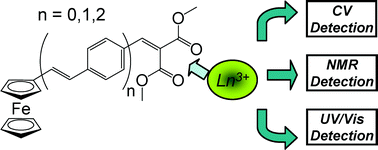Spectroscopic and electrochemical sensing of lanthanides with π-extended chromophores incorporating ferrocenes and a coordinative end†
Abstract
In this study, we report the synthesis and characterization of three novel “push–pull”

* Corresponding authors
a
Department of Chemistry, University of Pavia, Viale Taramelli, Pavia, Italy
E-mail:
dario.pasini@unipv.it
Web: http://www-2.unipv.it/labt/
Fax: +39 0382 987323
Tel: +39 0382 987835
b Department of Chemistry & Biochemistry, Calvin College, Grand Rapids, MI, USA
c Centro Grandi Strumenti, University of Pavia, Via Bassi, Pavia, Italy
d INSTM Research Unit, University of Pavia, Italy
In this study, we report the synthesis and characterization of three novel “push–pull”

 Please wait while we load your content...
Something went wrong. Try again?
Please wait while we load your content...
Something went wrong. Try again?
C. Coluccini, A. K. Sharma, D. Merli, D. Vander Griend, B. Mannucci and D. Pasini, Dalton Trans., 2011, 40, 11719 DOI: 10.1039/C1DT11031D
To request permission to reproduce material from this article, please go to the Copyright Clearance Center request page.
If you are an author contributing to an RSC publication, you do not need to request permission provided correct acknowledgement is given.
If you are the author of this article, you do not need to request permission to reproduce figures and diagrams provided correct acknowledgement is given. If you want to reproduce the whole article in a third-party publication (excluding your thesis/dissertation for which permission is not required) please go to the Copyright Clearance Center request page.
Read more about how to correctly acknowledge RSC content.
 Fetching data from CrossRef.
Fetching data from CrossRef.
This may take some time to load.
Loading related content
